EdTech 2 Instructional Software
Download as pptx, pdf9 likes7,137 views
Educational software was first used as a tutoring tool in the 1960s-1970s and has since evolved to incorporate drill and practice, tutorials, simulations, games, and problem solving. Today's instructional software uses both objectivist and constructivist learning concepts. It is a valuable tool for students of all ages but should not replace teachers - it is best used to supplement classroom instruction. Different types of educational software include drills and practice, tutorials, simulations, games, and problem solving software.
1 of 33
Downloaded 297 times
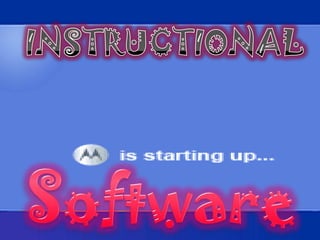
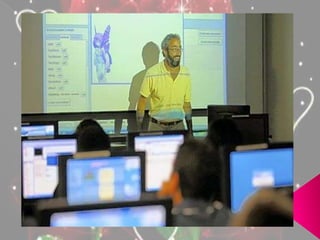
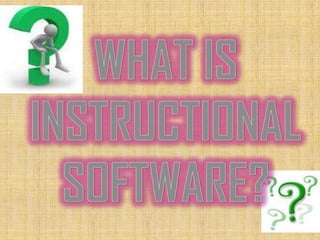
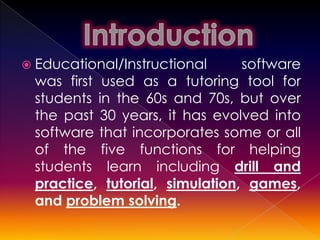
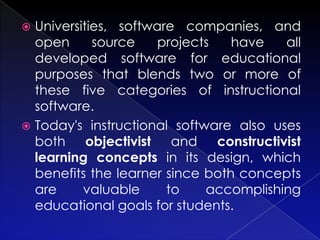

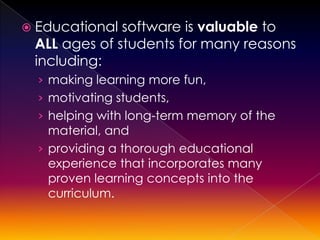
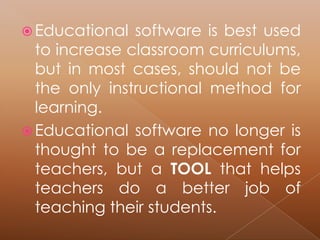
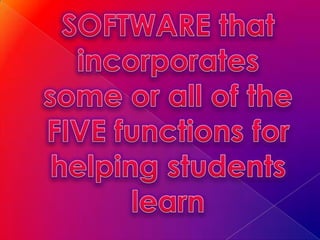
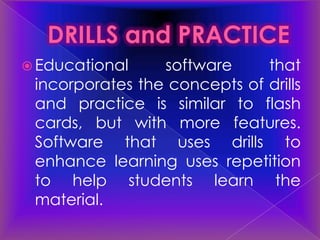
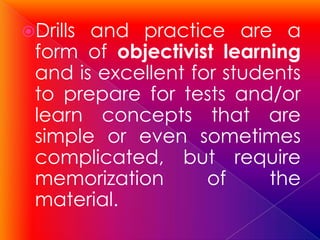
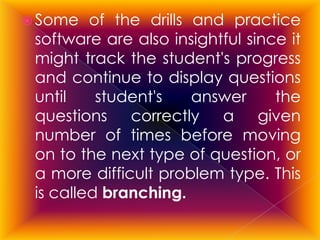
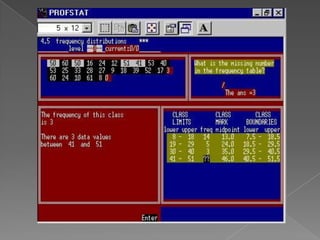
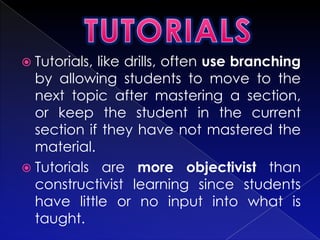

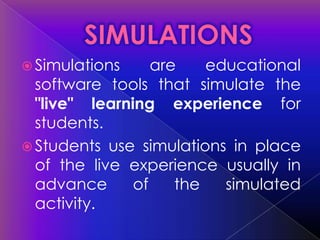


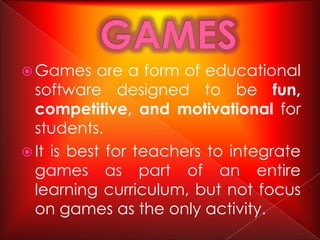
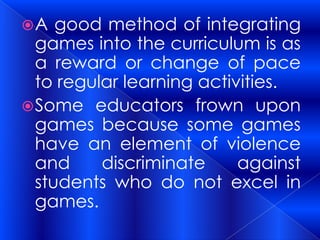
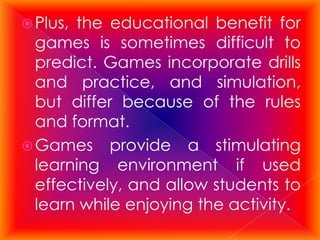
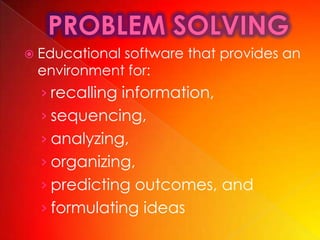


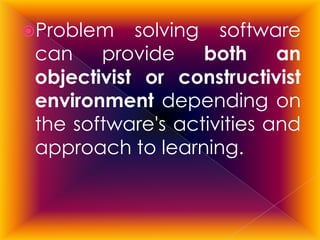


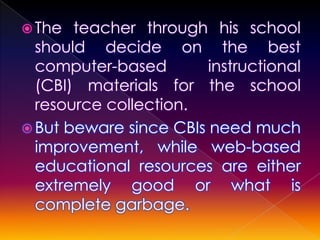

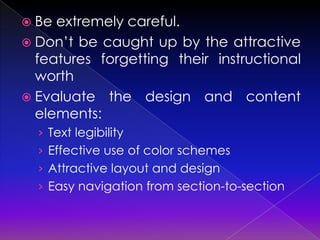
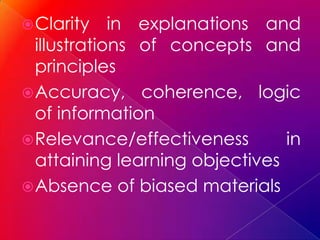
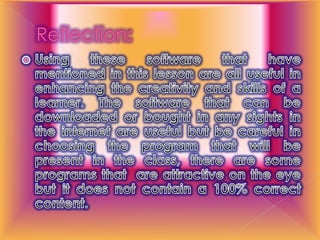

Ad
Recommended
Ed.tech.ii chapter 6 (instructional software for classroom use)
Ed.tech.ii chapter 6 (instructional software for classroom use)Chano Alfornon
╠²
The document discusses six types of instructional software: drill and practice, tutorial, simulation, instructional games, problem-solving, and software support tools. Each type is defined and guidelines for selecting, benefits, and limitations are provided. Drill and practice software allows practice and feedback, tutorial software acts like a tutor, simulation models systems, games add competition, problem-solving teaches problem-solving skills, and support tools improve efficiency. The document provides information on choosing and using different types of educational software in the classroom.Cone of experience
Cone of experienceRemelyn Calub
╠²
The document summarizes Dale's Cone of Experience, which depicts the relationship between different types of educational experiences and how close they are to reality. At the bottom of the cone are direct experiences, followed by contrived experiences, dramatized experiences, demonstrations, and so on up the cone getting further from reality, with verbal symbols at the top. The cone is used to help select instructional resources and activities based on allowing different sensory experiences and proximity to real-life.THE FLEXIBLE LEARNING ENVIRONMENT: Part I
THE FLEXIBLE LEARNING ENVIRONMENT: Part Ierwin marlon sario
╠²
The document discusses the evolution of distance learning, transitioning from traditional correspondence courses to online education facilitated by technologies such as Moodle, Google Classroom, and Edmodo. It emphasizes the shift in the role of teachers from knowledge dispensers to guides, reflecting a more flexible and accessible learning environment. Additionally, it covers various modes of online education, including synchronous and asynchronous learning, as well as blended learning models that integrate both online and in-person instruction.History of educational technology
History of educational technologyBicolanang Di MagBicol
╠²
This document provides a history of educational technology from ancient times to the modern era. It discusses how early technologies like the abacus aided counting and calculations. In the 19th century, technologies like textbooks, blackboards, and improved writing implements were introduced. Important developments included the invention of photography and instructional television. During World War II, the US government encouraged the use of technology for military training, spurring the development of technologies like microteaching and computer-assisted instruction. The introduction of computers in the 1950s, the development of the Internet and World Wide Web in the 1990s, and the rise of mobile technologies have transformed educational technology.Educational Technology 2: The computer as a tutor
Educational Technology 2: The computer as a tutor Alyssa Denise Valino
╠²
The document discusses the role of computers in education as tutors. It describes how computers can take on tutorial roles through computer-assisted instruction, allowing the teacher to focus on their roles as information deliverer and learning environment controller. The computer plays roles as a tutor by providing instruction, reinforcement through drill and practice, and feedback. Different types of educational software are discussed, including drill and practice programs, tutorial software, simulation programs, instructional games, and multimedia encyclopedias. The conclusion states that while computers do not replace teachers, they can enhance student learning by supporting different activities and assuming tutorial roles previously held by teachers.SOFTWARE FOR EDUCATORS AND STUDENTS
SOFTWARE FOR EDUCATORS AND STUDENTS Chano Alfornon
╠²
This document discusses different types of software used in education, including system software, operating systems, and application software. It describes stand-alone, embedded, and emerging operating systems like Windows, Mac OS X, iOS, Android, and Chrome OS. It also outlines types of application software used in schools like instructional software, productivity software, word processing, spreadsheets, and presentations. Finally, it briefly discusses graphics and multimedia software.Instructional materials (1)
Instructional materials (1)Catherine Matias
╠²
This document discusses non-digital instructional materials and their importance in education. It provides examples of commonly used non-digital materials like writing boards, flip charts, and nature tables. Guidelines for designing effective instructional materials include keeping them simple, legible, and consistent. The document also discusses digital tools in education like laptops, smart boards, and e-readers, and their benefits in enhancing communication, making learning more efficient and eco-friendly. Both non-digital and digital tools are important for teachers in delivering technology-enhanced lessons.Online resources, educational sites and portals
Online resources, educational sites and portalstcc_joemarie
╠²
Digital storytelling is a process of telling a story using digital means. It is an easy way to integrate technology into the classroom across subjects. The document provides examples of websites and apps that can be used for digital storytelling, including Tellagami for creating animated videos, VoiceThread for multimedia presentations and discussions, and Comic Creator for creating comic strips. It also shares guidance on how to use VoiceThread for different educational purposes. The source website provides resources for educational tools, apps, and technology integration for teachers. It emphasizes having an open mindset to learn about tools and adapt to changes as technologies evolve over time.Online Resources, Educational Sites and Portals
Online Resources, Educational Sites and PortalsIra Sagu
╠²
The document discusses educational resources and digital tools that can be used by teachers. It identifies several online portals and sites where educational resources can be found, including educatorstechnology.com. It also lists and provides brief descriptions of 16 digital tools that teachers can use, such as Audacity for audio editing, MakeBeliefsComix for creating comic strips, and EndNote for organizing research. Key attributes of teachers for effectively using digital tools are identified as openness to learn, having a positive attitude, being curious, having passion, and persevering.Drill and Practice method
Drill and Practice methodSaul Castellanos Chan
╠²
An instructional method is a set of steps teachers follow to implement their teaching approach, which can include presentations, demonstrations, and discussions. Drill and practice is a method where students learn by repeating previous knowledge at their own pace, such as through flashcard games, computer games, workbooks, and map recognition. Effective drill and practice introduces content before practice sessions, uses short frequent sessions over long ones, incorporates individual and group activities, adds competition to engage students, ensures correct practice, and provides opportunities to apply newly learned skills.Technology as Tutor
Technology as TutorNur-Aisha Pasandalan
╠²
The document discusses technology as a tutor for learning new software and applications. Technology-based tutorials allow students to learn at any time through step-by-step instructions. Intelligent tutoring systems also provide personalized support and feedback to improve learning. Examples of intelligent tutoring systems include integrated learning software and computer-adapted instructions. Online inquiry-based lessons that source all information from the internet are given as an example of an effective technology-based tutorial.Digital resources
Digital resourcessimmi barath
╠²
Digital resources encompass materials requiring computer access, including multimedia and interactive resources, enhancing learning through varied experiences. They offer substantial storage capacity, multimedia content, and facilitate easier access to information via CD-ROMs, DVDs, websites, e-books, and e-journals. The advantages include flexibility, improved accuracy of information, and a shift from traditional teaching methods to a more engaging, concept-applying approach.Assessing the Use of Learning Delivery Modalities
Assessing the Use of Learning Delivery Modalities FELICIANO III MUNGCAL
╠²
This document discusses different learning delivery modalities (LDMs) in light of changes in the education system. It defines key LDMs like face-to-face, distance, blended, and alternative delivery learning. For face-to-face, it outlines approaches like modified shifting of classes and ESM-focused teaching. Distance learning includes modular and online approaches. Blended learning combines methods. It also discusses challenges like parental roles, resource access, and managing multiple modalities. Factors to consider when choosing a modality include risk levels, school/learner contexts, and resource availability. Comparing LDMs applied to one's school and identifying issues are suggested outputs.Principles of Teaching 1
Principles of Teaching 1Joan Dagsan
╠²
The document outlines seven guiding principles for selecting effective teaching strategies: (1) Learning is active and involves hands-on activities, (2) Using multiple senses enhances learning, (3) A positive classroom environment without threats improves learning, (4) Emotion increases retention, (5) Meaningful connections to students' lives aids learning, (6) Teaching should go beyond recall to higher-order thinking, (7) An integrated approach addressing multiple intelligences and learning styles is most effective. The document advocates using brain-based strategies like visual aids, songs, projects and hands-on activities to create meaningful and engaging lessons. There is no single best method; teachers should consider objectives, content, students and policies to chooseIntegration of ICT in Teaching and Learning
Integration of ICT in Teaching and LearningSt.Xavier's College , Palayamkottai - 627 002
╠²
The document discusses the integration of Information and Communication Technology (ICT) in teaching and learning, highlighting its definition, characteristics, and benefits. It emphasizes the various ICT tools and techniques that enhance student engagement, collaboration, and understanding of complex concepts. The presentation concludes with considerations for both students and educators regarding the effective use of ICT in education.Instructional material
Instructional material Taghreed Hawsawi
╠²
This document discusses instructional materials used in education. It begins by outlining the learner objectives of being able to identify variables in selecting instructional materials, cite the components required to effectively communicate, and discuss general principles. It then defines instructional materials and their purpose in helping communicate information and improve student abilities. The three major components of instructional materials are identified as the delivery system, content, and presentation. Various types of written instructional materials like handouts, leaflets, books and pamphlets are discussed along with their advantages and disadvantages. The steps in developing learning resource materials and commercially prepared materials are also outlined.Instructional Game
Instructional Gamealsalmi
╠²
The document discusses instructional games, which are activities designed to motivate and engage learners through the addition of techniques and rules. It defines instructional games, outlines their components, uses, examples, advantages and disadvantages. Examples of instructional games include adventure games, role-playing games, board games, combat games, logic games and puzzles, and word games. The document concludes by thanking the reader for their attention and listing references used.SAMR Model
SAMR ModelDiana Benner
╠²
The document presents the SAMR model for technology integration in education, aiming to help educators understand its levelsŌĆöSubstitution, Augmentation, Modification, and Redefinition. It includes resources for lesson planning, activities related to the model, and links to further information about the use of technology in classrooms. The session encourages reflection on current technology use and offers methods to enhance teaching practices through the SAMR framework.Nature of Teaching
&
Characteristic of Teaching and Teacher
Nature of Teaching
&
Characteristic of Teaching and Teacher S. Raj Kumar
╠²
The document discusses the multifaceted role of teaching as a process of facilitating learning and interaction between teachers and students. It emphasizes the importance of educators in shaping future citizens and highlights various teaching methods and qualities necessary for effective teaching. Additionally, it outlines the significance of empathy, creativity, and ethical behavior in fostering a positive learning environment.Lesson5 coneofexperience
Lesson5 coneofexperienceBrijida Charizma Ardo├▒a-Navarro
╠²
The document discusses Edgar Dale's Cone of Experience, which arranges various educational experiences from most concrete to most abstract. Direct experiences are closest to real life, while verbal symbols are the most abstract. The cone shows that mixing media which appeal to multiple senses helps learning. It cautions against overreliance on one type of experience and emphasizes moving between concrete and abstract. Bruner's model of enactive, iconic, and symbolic learning parallels the cone's arrangement from hands-on to abstract.The cone of experience
The cone of experienceKristine Ann de Jesus
╠²
The Cone of Experience is a model created by Edgar Dale that graphically represents the relationship between different types of learning experiences and their effectiveness. It ranges from direct, hands-on experiences at the bottom to abstract, symbolic representations at the top. The cone is meant to show that learning is generally most effective when it progresses from concrete to abstract. It influences teachers to incorporate a variety of instructional methods and media into their lessons to engage different types of learners.Guiding Principles in the Selection and Use of Teaching Strategies
Guiding Principles in the Selection and Use of Teaching Strategiessheisirenebkm
╠²
The mini-symposium at the University of Santo Tomas focused on guiding principles in selecting and using teaching strategies, emphasizing the importance of active learning and engaging multiple senses for better retention. Key suggestions included creating a non-threatening classroom atmosphere, fostering a culture of respect, and encouraging collaboration among students. The document also highlights the necessity of making learning comfortable to promote positive educational responses.The elementary curriculum
The elementary curriculumKevin Mike Simblante
╠²
The document outlines the Elementary Curriculum in the Philippines and proposed refinements. It discusses (1) evaluating and addressing issues with the previous curriculum, (2) directions for intensifying skills development, higher-order thinking, and interactive learning strategies, and (3) existing and new programs to support curriculum refinement like special education, multilingual education, science schools, and ICT integration. The intended outcome is scaling up successful models through community participation to develop students' skills and values for lifelong learning.The 21st century teacher and learner
The 21st century teacher and learner Cordova Public College and University of Cebu-LapuLapu-Mandaue
╠²
The document outlines the essential 21st century skills for teachers and learners in the K-12 education system, including visual, media, and technological literacies, as well as critical thinking and collaboration skills. It emphasizes the role of teachers as adaptable communicators, lifelong learners, and innovative leaders who model desired behaviors while leveraging technology and collaborative tools to enhance student learning. The ideal learning environment prioritizes inquiry, creativity, and global connections, distinguishing between 20th century and 21st century learning approaches.Integration of tecnology in education ppt.
Integration of tecnology in education ppt.Cherymae Almacen
╠²
The document discusses the benefits of integrating technology into education. It states that technology tools can make teaching easier and more engaging for students. When used effectively, technology can facilitate active learning, meet individual student needs, and provide authentic learning experiences. For technology integration to be successful, technology resources must be accessible and used regularly in the classroom rather than just for viewing content. The document also notes that technology skills are necessary for students to develop for future success and that technology can increase teacher productivity.Learner centered teaching
Learner centered teaching┘ģ┘å┘ē ž╣ž©ž» ž¦┘ä┘üž¬ž¦žŁ
╠²
The document discusses learner-centered teaching, which emphasizes students' active participation in their learning process, challenging traditional teacher-centered methods. It highlights key differences between these paradigms, such as the role of the instructor, the type of knowledge acquisition, and the cultural atmosphere of the classroom. The document advocates for practical strategies to empower students and foster a collaborative learning environment that enhances critical thinking and problem-solving skills.Ed 3 Unit 4 Chapter 1 Guiding Principles in Classroom Management
Ed 3 Unit 4 Chapter 1 Guiding Principles in Classroom ManagementJasmine Pascual
╠²
This document outlines principles for effective classroom management. It states that classroom management is a necessary condition for teaching, as teachers cannot effectively teach classes that are inattentive or unruly. Some key principles discussed include establishing consistent routines, orchestrating smooth transitions to minimize downtime, balancing variety and challenge in activities to engage different learners, being aware of all classroom activities, addressing minor issues before they escalate, reinforcing positive behavior, and making good use of instructional time. The overall message is that proactive and organized classroom management is crucial to facilitating student learning.History Of Educational Technology
History Of Educational TechnologyLaguna State Polytechnic University
╠²
The document provides a history of educational technology from ancient times to modern day:
- Educational technology has its roots in ancient Greece where knowledge was systematically organized and instructional methods were developed.
- Major advances included the development of visual aids in the 19th century, educational films in the 1920s, instructional television in the 1930s, and the introduction of computers and the internet in recent decades.
- Today, educational technology encompasses a variety of tools and approaches aimed at addressing educational needs through the application of current technologies like computers and networks.Computer as ttur
Computer as tturSFYC
╠²
Computer-based instruction can take several forms including computer-assisted instruction (CAI), computer-managed instruction (CMI), and computer-enriched instruction (CEI). CAI refers to using educational software or drill-and-practice, tutorials, or simulations to supplement traditional teaching. CAI software evaluates student performance, guides students to appropriate resources, and tracks their progress. Common types of CAI software include drill-and-practice, tutorials, simulations, games, and problem-solving programs. CAI provides individualized learning opportunities and immediate feedback to students.Thefutureeducator 91788-pred-213-learning-based-technology-education-educatio...
Thefutureeducator 91788-pred-213-learning-based-technology-education-educatio...SFYC
╠²
The document discusses different types of computer-based education including computer-assisted instruction (CAI). CAI refers to instruction or remediation presented on a computer using educational software. The summary discusses the main types of CAI software:
1. Drill-and-practice software focuses on memorization through repetition of questions and feedback.
2. Tutorial software introduces new concepts through interactive multimedia presentations while assessing student understanding.
3. Simulation software allows students to experience realistic situations through role-playing and exploring the consequences of decisions.
4. CAI has advantages like individualized instruction and tracking student progress, but also disadvantages like potential equipment issues.More Related Content
What's hot (20)
Online Resources, Educational Sites and Portals
Online Resources, Educational Sites and PortalsIra Sagu
╠²
The document discusses educational resources and digital tools that can be used by teachers. It identifies several online portals and sites where educational resources can be found, including educatorstechnology.com. It also lists and provides brief descriptions of 16 digital tools that teachers can use, such as Audacity for audio editing, MakeBeliefsComix for creating comic strips, and EndNote for organizing research. Key attributes of teachers for effectively using digital tools are identified as openness to learn, having a positive attitude, being curious, having passion, and persevering.Drill and Practice method
Drill and Practice methodSaul Castellanos Chan
╠²
An instructional method is a set of steps teachers follow to implement their teaching approach, which can include presentations, demonstrations, and discussions. Drill and practice is a method where students learn by repeating previous knowledge at their own pace, such as through flashcard games, computer games, workbooks, and map recognition. Effective drill and practice introduces content before practice sessions, uses short frequent sessions over long ones, incorporates individual and group activities, adds competition to engage students, ensures correct practice, and provides opportunities to apply newly learned skills.Technology as Tutor
Technology as TutorNur-Aisha Pasandalan
╠²
The document discusses technology as a tutor for learning new software and applications. Technology-based tutorials allow students to learn at any time through step-by-step instructions. Intelligent tutoring systems also provide personalized support and feedback to improve learning. Examples of intelligent tutoring systems include integrated learning software and computer-adapted instructions. Online inquiry-based lessons that source all information from the internet are given as an example of an effective technology-based tutorial.Digital resources
Digital resourcessimmi barath
╠²
Digital resources encompass materials requiring computer access, including multimedia and interactive resources, enhancing learning through varied experiences. They offer substantial storage capacity, multimedia content, and facilitate easier access to information via CD-ROMs, DVDs, websites, e-books, and e-journals. The advantages include flexibility, improved accuracy of information, and a shift from traditional teaching methods to a more engaging, concept-applying approach.Assessing the Use of Learning Delivery Modalities
Assessing the Use of Learning Delivery Modalities FELICIANO III MUNGCAL
╠²
This document discusses different learning delivery modalities (LDMs) in light of changes in the education system. It defines key LDMs like face-to-face, distance, blended, and alternative delivery learning. For face-to-face, it outlines approaches like modified shifting of classes and ESM-focused teaching. Distance learning includes modular and online approaches. Blended learning combines methods. It also discusses challenges like parental roles, resource access, and managing multiple modalities. Factors to consider when choosing a modality include risk levels, school/learner contexts, and resource availability. Comparing LDMs applied to one's school and identifying issues are suggested outputs.Principles of Teaching 1
Principles of Teaching 1Joan Dagsan
╠²
The document outlines seven guiding principles for selecting effective teaching strategies: (1) Learning is active and involves hands-on activities, (2) Using multiple senses enhances learning, (3) A positive classroom environment without threats improves learning, (4) Emotion increases retention, (5) Meaningful connections to students' lives aids learning, (6) Teaching should go beyond recall to higher-order thinking, (7) An integrated approach addressing multiple intelligences and learning styles is most effective. The document advocates using brain-based strategies like visual aids, songs, projects and hands-on activities to create meaningful and engaging lessons. There is no single best method; teachers should consider objectives, content, students and policies to chooseIntegration of ICT in Teaching and Learning
Integration of ICT in Teaching and LearningSt.Xavier's College , Palayamkottai - 627 002
╠²
The document discusses the integration of Information and Communication Technology (ICT) in teaching and learning, highlighting its definition, characteristics, and benefits. It emphasizes the various ICT tools and techniques that enhance student engagement, collaboration, and understanding of complex concepts. The presentation concludes with considerations for both students and educators regarding the effective use of ICT in education.Instructional material
Instructional material Taghreed Hawsawi
╠²
This document discusses instructional materials used in education. It begins by outlining the learner objectives of being able to identify variables in selecting instructional materials, cite the components required to effectively communicate, and discuss general principles. It then defines instructional materials and their purpose in helping communicate information and improve student abilities. The three major components of instructional materials are identified as the delivery system, content, and presentation. Various types of written instructional materials like handouts, leaflets, books and pamphlets are discussed along with their advantages and disadvantages. The steps in developing learning resource materials and commercially prepared materials are also outlined.Instructional Game
Instructional Gamealsalmi
╠²
The document discusses instructional games, which are activities designed to motivate and engage learners through the addition of techniques and rules. It defines instructional games, outlines their components, uses, examples, advantages and disadvantages. Examples of instructional games include adventure games, role-playing games, board games, combat games, logic games and puzzles, and word games. The document concludes by thanking the reader for their attention and listing references used.SAMR Model
SAMR ModelDiana Benner
╠²
The document presents the SAMR model for technology integration in education, aiming to help educators understand its levelsŌĆöSubstitution, Augmentation, Modification, and Redefinition. It includes resources for lesson planning, activities related to the model, and links to further information about the use of technology in classrooms. The session encourages reflection on current technology use and offers methods to enhance teaching practices through the SAMR framework.Nature of Teaching
&
Characteristic of Teaching and Teacher
Nature of Teaching
&
Characteristic of Teaching and Teacher S. Raj Kumar
╠²
The document discusses the multifaceted role of teaching as a process of facilitating learning and interaction between teachers and students. It emphasizes the importance of educators in shaping future citizens and highlights various teaching methods and qualities necessary for effective teaching. Additionally, it outlines the significance of empathy, creativity, and ethical behavior in fostering a positive learning environment.Lesson5 coneofexperience
Lesson5 coneofexperienceBrijida Charizma Ardo├▒a-Navarro
╠²
The document discusses Edgar Dale's Cone of Experience, which arranges various educational experiences from most concrete to most abstract. Direct experiences are closest to real life, while verbal symbols are the most abstract. The cone shows that mixing media which appeal to multiple senses helps learning. It cautions against overreliance on one type of experience and emphasizes moving between concrete and abstract. Bruner's model of enactive, iconic, and symbolic learning parallels the cone's arrangement from hands-on to abstract.The cone of experience
The cone of experienceKristine Ann de Jesus
╠²
The Cone of Experience is a model created by Edgar Dale that graphically represents the relationship between different types of learning experiences and their effectiveness. It ranges from direct, hands-on experiences at the bottom to abstract, symbolic representations at the top. The cone is meant to show that learning is generally most effective when it progresses from concrete to abstract. It influences teachers to incorporate a variety of instructional methods and media into their lessons to engage different types of learners.Guiding Principles in the Selection and Use of Teaching Strategies
Guiding Principles in the Selection and Use of Teaching Strategiessheisirenebkm
╠²
The mini-symposium at the University of Santo Tomas focused on guiding principles in selecting and using teaching strategies, emphasizing the importance of active learning and engaging multiple senses for better retention. Key suggestions included creating a non-threatening classroom atmosphere, fostering a culture of respect, and encouraging collaboration among students. The document also highlights the necessity of making learning comfortable to promote positive educational responses.The elementary curriculum
The elementary curriculumKevin Mike Simblante
╠²
The document outlines the Elementary Curriculum in the Philippines and proposed refinements. It discusses (1) evaluating and addressing issues with the previous curriculum, (2) directions for intensifying skills development, higher-order thinking, and interactive learning strategies, and (3) existing and new programs to support curriculum refinement like special education, multilingual education, science schools, and ICT integration. The intended outcome is scaling up successful models through community participation to develop students' skills and values for lifelong learning.The 21st century teacher and learner
The 21st century teacher and learner Cordova Public College and University of Cebu-LapuLapu-Mandaue
╠²
The document outlines the essential 21st century skills for teachers and learners in the K-12 education system, including visual, media, and technological literacies, as well as critical thinking and collaboration skills. It emphasizes the role of teachers as adaptable communicators, lifelong learners, and innovative leaders who model desired behaviors while leveraging technology and collaborative tools to enhance student learning. The ideal learning environment prioritizes inquiry, creativity, and global connections, distinguishing between 20th century and 21st century learning approaches.Integration of tecnology in education ppt.
Integration of tecnology in education ppt.Cherymae Almacen
╠²
The document discusses the benefits of integrating technology into education. It states that technology tools can make teaching easier and more engaging for students. When used effectively, technology can facilitate active learning, meet individual student needs, and provide authentic learning experiences. For technology integration to be successful, technology resources must be accessible and used regularly in the classroom rather than just for viewing content. The document also notes that technology skills are necessary for students to develop for future success and that technology can increase teacher productivity.Learner centered teaching
Learner centered teaching┘ģ┘å┘ē ž╣ž©ž» ž¦┘ä┘üž¬ž¦žŁ
╠²
The document discusses learner-centered teaching, which emphasizes students' active participation in their learning process, challenging traditional teacher-centered methods. It highlights key differences between these paradigms, such as the role of the instructor, the type of knowledge acquisition, and the cultural atmosphere of the classroom. The document advocates for practical strategies to empower students and foster a collaborative learning environment that enhances critical thinking and problem-solving skills.Ed 3 Unit 4 Chapter 1 Guiding Principles in Classroom Management
Ed 3 Unit 4 Chapter 1 Guiding Principles in Classroom ManagementJasmine Pascual
╠²
This document outlines principles for effective classroom management. It states that classroom management is a necessary condition for teaching, as teachers cannot effectively teach classes that are inattentive or unruly. Some key principles discussed include establishing consistent routines, orchestrating smooth transitions to minimize downtime, balancing variety and challenge in activities to engage different learners, being aware of all classroom activities, addressing minor issues before they escalate, reinforcing positive behavior, and making good use of instructional time. The overall message is that proactive and organized classroom management is crucial to facilitating student learning.History Of Educational Technology
History Of Educational TechnologyLaguna State Polytechnic University
╠²
The document provides a history of educational technology from ancient times to modern day:
- Educational technology has its roots in ancient Greece where knowledge was systematically organized and instructional methods were developed.
- Major advances included the development of visual aids in the 19th century, educational films in the 1920s, instructional television in the 1930s, and the introduction of computers and the internet in recent decades.
- Today, educational technology encompasses a variety of tools and approaches aimed at addressing educational needs through the application of current technologies like computers and networks.The 21st century teacher and learner
The 21st century teacher and learner Cordova Public College and University of Cebu-LapuLapu-Mandaue
╠²
Similar to EdTech 2 Instructional Software (20)
Computer as ttur
Computer as tturSFYC
╠²
Computer-based instruction can take several forms including computer-assisted instruction (CAI), computer-managed instruction (CMI), and computer-enriched instruction (CEI). CAI refers to using educational software or drill-and-practice, tutorials, or simulations to supplement traditional teaching. CAI software evaluates student performance, guides students to appropriate resources, and tracks their progress. Common types of CAI software include drill-and-practice, tutorials, simulations, games, and problem-solving programs. CAI provides individualized learning opportunities and immediate feedback to students.Thefutureeducator 91788-pred-213-learning-based-technology-education-educatio...
Thefutureeducator 91788-pred-213-learning-based-technology-education-educatio...SFYC
╠²
The document discusses different types of computer-based education including computer-assisted instruction (CAI). CAI refers to instruction or remediation presented on a computer using educational software. The summary discusses the main types of CAI software:
1. Drill-and-practice software focuses on memorization through repetition of questions and feedback.
2. Tutorial software introduces new concepts through interactive multimedia presentations while assessing student understanding.
3. Simulation software allows students to experience realistic situations through role-playing and exploring the consequences of decisions.
4. CAI has advantages like individualized instruction and tracking student progress, but also disadvantages like potential equipment issues.Tech21114 1219035435386427-8
Tech21114 1219035435386427-8Anel Marecio
╠²
The document defines and provides examples of 8 types of instructional software:
1. Applications such as MS Excel that teach skills and enhance problem solving.
2. Drill and practice software that reinforce skills through repetition like math fact programs.
3. Tutorials that guide learners through new material with pre/post tests like language lessons.
4. Simulations that model real or imagined systems to teach processes through experimentation like physics simulators.
5. Instructional games that motivate learning through challenges and competition like math games.
6. Problem-solving software that develop thinking through open-ended problems like mechanics problem sets.
7. Multimedia programs that engage multiple senses using text, images, videoTypes of Instructional Software
Types of Instructional SoftwareAlaa Sadik
╠²
The document defines and provides examples of 8 types of instructional software:
1. Applications such as MS Excel that teach skills and enhance problem solving.
2. Drill and practice software that reinforce skills through repetition like ECS Keyboard.
3. Tutorials like an Auslan sign language tutorial that guide learners through material.
4. Simulations like physics simulators that allow experimentation in safe environments.
5. Instructional games that make learning fun through challenges and competition like Save the Math Apples.
6. Problem-solving software that emphasize thinking over answers like StressAlyzer.
7. Multimedia programs that engage multiple learning styles using various media like Scholar's Desktop.Chapter 8
Chapter 8Sabeeta Lohana
╠²
The document discusses several teaching strategies and methods including:
1. Cooperative learning strategies like jigsaw that allow students to work together and learn from different perspectives.
2. Inquiry-based instruction that engages students by asking questions to develop a deeper understanding of content.
3. Differentiated instruction using learning stations to accommodate different learning styles.
4. Use of graphic organizers to help students organize and comprehend information visually.
5. Integrating technology into lessons to keep students engaged.
It also discusses newer teaching methods like spaced learning that combines lessons with physical breaks, flexible Fridays focusing on individual subjects, and engagement through real-world experiences outside the classroom. Simulation, team teaching, and their advantagesTypes of Instructional Software
Types of Instructional SoftwareAlaa Sadik
╠²
The document outlines various types of instructional software, including applications, drill-and-practice, tutorials, simulations, instructional games, problem-solving software, multimedia, and teacher utilities. Each category includes definitions, features, and examples to illustrate how they enhance learning and teaching processes. The document serves as a comprehensive resource for understanding the taxonomy and purpose of different instructional software tools.Instructional software
Instructional softwarecholthaus
╠²
This document discusses different types of instructional software and their functions. It defines instructional software as computer programs designed to deliver instruction or assist with instruction on a topic. The main types discussed are drill and practice, tutorial, simulation, instructional games, and problem-solving. Each type is defined and its relative advantages, uses, and benefits are outlined. Examples of software are provided for each type.Computer Assisted Instruction
Computer Assisted InstructionVismayaMD
╠²
This document discusses computer assisted instruction (CAI) in education. It defines CAI as an interactive instructional technique using computers to present material and monitor learning. CAI allows individualized self-paced instruction. It describes different types of CAI including drill and practice, tutorials, games, and simulations. The document also outlines the characteristics, features, uses, role of teachers, merits, and limitations of CAI. It concludes that while CAI has benefits for students, teachers are still needed to support learning and address limitations.EdTech 541: Instructional Software
EdTech 541: Instructional Softwaremlong24
╠²
This document discusses different types of instructional software that can be used for middle school math including drill and practice software, tutorial software, simulation software, educational game software, and problem-solving software. It provides examples of specific software for each type, such as IXL Math for drill and practice or Khan Academy for tutorials. The document also discusses the benefits of using instructional software in the classroom, such as increased motivation and self-paced learning.Drill
Drillu061423
╠²
Drill and practice refers to the repetitive review of previously learned concepts to achieve mastery. It promotes acquisition of knowledge or skills through repetitive practice of small tasks like memorizing spelling words or practicing math facts. Drill and practice helps learners master material at their own pace through reinforcement and is useful for beginning learners or those struggling. It is best used for skills that form the building blocks for more complex learning.CAI & CAL
CAI & CALMandeep Gill
╠²
Computer-Assisted Instruction (CAI) is an interactive educational method that utilizes computers to enhance learning through self-paced, self-directed, and multisensory experiences. Research indicates that CAI improves student learning rates, retention of information, and positive attitudes towards learning compared to traditional methods. Various delivery modes such as tutorials, simulations, drills, and games are employed to engage learners and facilitate the mastery of complex concepts.Instructional software
Instructional softwareRodessa Marie Canillas
╠²
The document discusses different types of instructional software: drill and practice software, tutorials, simulations, instructional games, problem-solving software, and multimedia programs. It provides definitions and examples for each type. Drill and practice software provides exercises to reinforce skills through repetition. Tutorials present new material through pre- and post-tests and practice activities. Simulations model real or imaginary systems to teach how systems work. Instructional games add game elements to motivate learning. Problem-solving software emphasizes critical thinking through presentation of data or problems. Multimedia programs combine text, audio, images and video to engage different learning styles. 7 Surefire Tips for Remote Teaching: Make Learning Engaging
7 Surefire Tips for Remote Teaching: Make Learning EngagingKavika Roy
╠²
The document outlines challenges and solutions for effective remote teaching, emphasizing the drawbacks of isolated learning and lack of peer motivation. It provides practical tips for teachers to enhance engagement by being available, improving technical skills, leveraging edtech tools, and incorporating ongoing feedback. Additionally, it suggests making assignments more relevant to the online environment to better facilitate learning.ENGLISH-REPORT-UNIT-6-_BY-SHAYNEANGELA-AND-PAULINE-BEED2A..pptx
ENGLISH-REPORT-UNIT-6-_BY-SHAYNEANGELA-AND-PAULINE-BEED2A..pptxMarjoriAnneDelosReye
╠²
The document discusses explicit teaching as an instructional strategy. It begins by defining explicit teaching as an unambiguous, direct approach that includes instructional design and delivery procedures. It describes the key elements of explicit teaching as breaking concepts into parts, clearly explaining and modeling skills, providing guided and independent practice, and promoting high student-teacher interaction. The document provides examples of how to implement explicit teaching, such as ensuring students have prerequisites, modeling skills multiple times, and linking steps to previous learning. It concludes by emphasizing the importance of being clear about learning goals and giving students time to practice skills they have learned.Top 10 Apps for Learning and Teaching: Group 4
Top 10 Apps for Learning and Teaching: Group 4ccauthon
╠²
The document summarizes 10 popular apps for teaching and learning. It provides the name of each app and a brief rationale for its selection focusing on benefits like improved communication, engagement, assessment, and collaboration. Key apps include Google Classroom for organization, Socrative and Kahoot! for interactive lessons, Plickers and Nearpod for assessments without devices, and Brainpop, Seesaw and Read Theory for content and student portfolios. Overall, the apps aim to enhance learning, participation, and feedback in fun, engaging ways.Top 10 apps presentation group 4
Top 10 apps presentation group 4David Dillion
╠²
The document discusses 10 popular apps for teaching and learning. It provides a brief rationale for each app, highlighting their key benefits. Google Classroom improves communication and organization while allowing learning beyond the classroom. Socrative and Kahoot! make learning engaging through games and immediate feedback. TeacherKit, Seesaw, and Nearpod help with organization and allowing students to demonstrate learning. Plickers, BrainPop, Read Theory, and Class Dojo support specific functions like behavior tracking, reading comprehension, and communication with parents.Top 10 apps presentation: group 4
Top 10 apps presentation: group 4Devon Loth
╠²
The document discusses 10 apps that are useful for teaching and learning: Google Classroom, Socrative, TeacherKit, Class Dojo, Read Theory, Seesaw, Kahoot, Plickers, BrainPop, and NearPod. Google Classroom allows teachers to organize lessons, communicate with students, and provide feedback on assignments. Socrative and Kahoot engage students through interactive games and quizzes. TeacherKit, Class Dojo, and Read Theory help with classroom organization, behavior management, and reading assessment. Seesaw, BrainPop, and NearPod enrich lessons through multimedia content and encourage collaboration.Teacher Centered VS Student Centered Learning Which one is Better.pdf
Teacher Centered VS Student Centered Learning Which one is Better.pdfChloe Cheney
╠²
The document discusses the differences between teacher-centered and student-centered learning, highlighting the shortcomings of the former in fostering student engagement and cognitive development. It emphasizes that student-centered learning promotes active participation, problem-solving skills, and confidence in students, making it a more effective educational approach. The text also outlines practical steps to create a student-centered learning environment, particularly in virtual settings.Educational Technology 2
Educational Technology 2culaba28
╠²
The computer plays an important role in modern education by acting as a tutor through programmed instruction, allowing it to deliver learning content, provide practice and feedback to students, and help reinforce learning. However, the teacher's role remains central as an information deliverer, learning environment controller, and facilitator to guide students. Different types of educational software, including drill and practice, simulations, instructional games, multimedia encyclopedias and electronic books, can support learning in various subject areas while developing students' skills.C a
C achemistry2k5
╠²
The ASSURE model is a 6 step process for designing instruction that incorporates technology:
1. Analyze learners to understand their characteristics and skills
2. State clear objectives for what learners will be able to do
3. Select appropriate media and materials to meet the objectives
4. Utilize the media and materials in the lesson
5. Require active learner participation and practice
6. Evaluate the results and revise the lesson accordinglyAd
EdTech 2 Instructional Software
- 4. ’é× Educational/Instructional software was first used as a tutoring tool for students in the 60s and 70s, but over the past 30 years, it has evolved into software that incorporates some or all of the five functions for helping students learn including drill and practice, tutorial, simulation, games, and problem solving.
- 5. ’é× Universities, software companies, and open source projects have all developed software for educational purposes that blends two or more of these five categories of instructional software. ’é× Today's instructional software also uses both objectivist and constructivist learning concepts in its design, which benefits the learner since both concepts are valuable to accomplishing educational goals for students.
- 6. Objectivist View Constructivist View Knowledge exists outside of Knowledge has personal individuals and can be meaning. It is created by transferred from teachers to students. individual students. Students learn what they Learners construct their hear and what they read. own knowledge by If a teacher explains looking for meaning and abstract concepts well, order; they interpret what students will learn those they hear, read, and see concepts. based on their previous learning and habits. Learning is successful Learning is successful when students can repeat when students can what was taught. demonstrate conceptual understanding.
- 7. ’é× Educational software is valuable to ALL ages of students for many reasons including: ŌĆ║ making learning more fun, ŌĆ║ motivating students, ŌĆ║ helping with long-term memory of the material, and ŌĆ║ providing a thorough educational experience that incorporates many proven learning concepts into the curriculum.
- 8. ’é× Educational software is best used to increase classroom curriculums, but in most cases, should not be the only instructional method for learning. ’é× Educational software no longer is thought to be a replacement for teachers, but a TOOL that helps teachers do a better job of teaching their students.
- 10. ’é× Educational software that incorporates the concepts of drills and practice is similar to flash cards, but with more features. Software that uses drills to enhance learning uses repetition to help students learn the material.
- 11. ’é×Drillsand practice are a form of objectivist learning and is excellent for students to prepare for tests and/or learn concepts that are simple or even sometimes complicated, but require memorization of the material.
- 12. ’é× Some of the drills and practice software are also insightful since it might track the student's progress and continue to display questions until student's answer the questions correctly a given number of times before moving on to the next type of question, or a more difficult problem type. This is called branching.
- 14. ’é× Tutorials,like drills, often use branching by allowing students to move to the next topic after mastering a section, or keep the student in the current section if they have not mastered the material. ’é× Tutorials are more objectivist than constructivist learning since students have little or no input into what is taught.
- 15. ’é× Tutorials are difficult and expensive to develop, which explain why developers choose tutorials less than other types of educational software to develop. ’é× Tutorials should use a comprehensive approach to instruction and simulate a real classroom experience to teach students the entire learning goals of a subject.
- 16. ’é× Simulations are educational software tools that simulate the "live" learning experience for students. ’é× Students use simulations in place of the live experience usually in advance of the simulated activity.
- 17. ’é× The use of simulations saves money and replaces activities that might be not practical or may be even dangerous until the student learns the activity. ’é× Simulations usually allow many different students the opportunity to participate in the simulated (imitation) activity an unlimited number of times in order to master the activity before participating with the actual activity they are learning.
- 18. ’é×Examples of the types of learning environments to be simulated are: ŌĆ║ a chemistry experiment, ŌĆ║ operation of an automobile or airplane, or ŌĆ║ biology or medical procedures.
- 19. ’é× Games are a form of educational software designed to be fun, competitive, and motivational for students. ’é× It is best for teachers to integrate games as part of an entire learning curriculum, but not focus on games as the only activity.
- 20. ’é×A good method of integrating games into the curriculum is as a reward or change of pace to regular learning activities. ’é× Some educators frown upon games because some games have an element of violence and discriminate against students who do not excel in games.
- 21. ’é× Plus,the educational benefit for games is sometimes difficult to predict. Games incorporate drills and practice, and simulation, but differ because of the rules and format. ’é× Games provide a stimulating learning environment if used effectively, and allow students to learn while enjoying the activity.
- 22. ’é× Educational software that provides an environment for: ŌĆ║ recalling information, ŌĆ║ sequencing, ŌĆ║ analyzing, ŌĆ║ organizing, ŌĆ║ predicting outcomes, and ŌĆ║ formulating ideas
- 23. ’é×P░∙┤Ū▓·▒¶▒│Š solving software helps students learn a sequence of events that leads to the solution, and is often included in math and science educational software packages.
- 24. ’é× Problem solving software is motivational and improves the interest of the subject for students, but it is often difficult to measure its effectiveness and can sometimes frustrate students who have difficulties reaching the final solution.
- 25. ’é×P░∙┤Ū▓·▒¶▒│Š solving software can provide both an objectivist or constructivist environment depending on the software's activities and approach to learning.
- 28. ’é× The teacher through his school should decide on the best computer-based instructional (CBI) materials for the school resource collection. ’é× But beware since CBIs need much improvement, while web-based educational resources are either extremely good or what is complete garbage.
- 30. ’é× Be extremely careful. ’é× DonŌĆÖt be caught up by the attractive features forgetting their instructional worth ’é× Evaluate the design and content elements: ŌĆ║ Text legibility ŌĆ║ Effective use of color schemes ŌĆ║ Attractive layout and design ŌĆ║ Easy navigation from section-to-section
- 31. ’é× Clarity in explanations and illustrations of concepts and principles ’é× Accuracy, coherence, logic of information ’é× Relevance/effectiveness in attaining learning objectives ’é× Absence of biased materials
